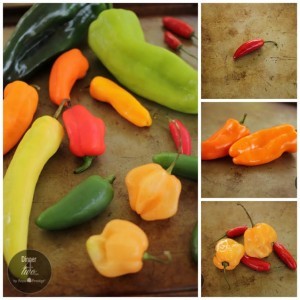Let’s talk chili peppers …They’re a work horse when it comes to flavor and adding a kick in the kitchen to your recipes.
There’re over 400 species of chilies throughout the world and they come in a variety of heat levels as well as sweetness.
Finding the balance…when it comes to the level of heat you want in your dish there are a few things to think about and consider. If you are looking to deliver full flavor and the kick of the heat to your dish then you’ll want to include both the white ribs of the fruit and some of the seeds. If you desire flavor with minimal heat then eliminate the white ribs, seeds and wash the fruit’s insides a few times in cold water; you can eliminate 70-80% of the heat. This will deliver a full depth of flavor. If you’re looking for a balance between flavor and heat add some of the white ribs and a small portion of the seeds to your dish.
The 411 on the heat scale…heat is measured in Scoville units. It’s based on the strength of capsicum in a given pepper. The fiery sensation of capsicum is a potent chemical that survives both cooking and freezing.
Here’s the upside to the down side of that heat; the chemical capsicum triggers the brain to produce endorphins, natural pain killers that promote a sense of well being. Who doesn’t love a little endorphin boost!
The Scoville scale starts at 0 with the mild green peppers and goes up to 15,000,000-16,000,000 for pure capsicum. The world’s hottest chili is the Carolina Reaper at a score of 2,200,000. By the way this queen of the heat scale also holds the Guinness book of world records. The jalapeno pepper is on the lower end and packs 2,500 – 5,000 score. See the chart below to check the heat score of your favorite chili.
We can’t talk about chilies without a word of caution, be sure when working with chilies that you don’t touch your face or eyes. This will deliver a burn that you will not soon forget! When working with hotter chilies it’s strongly suggested to wear gloves.
If you decide to try your hand at cultivating your own crop of these jewels of the garden you won’t be disappointed. It’s one of the easiest fruits to grow whether it’s in the garden or on the patio in a pot; they’ll produce abundantly for you. They are easy to start by seeds inside the house or sow outside after any danger of frost has passed.
The fruit can be picked when it is green or you can leave it on the vine for an extra 2-3 weeks until it reaches full maturity. It will turn a variety of beautiful colors, red, orange, and yellow and depending on the variety it may turn a chocolate or purple color. Sweet peppers become sweeter as they ripen on the vine.
Nutritionally speaking hot red peppers get the highest marks; they contain about 14 times more beta-carotene than a hot green pepper, however, the vitamin C content is the same. Sweet red peppers are at the head of the class for sweet peppers; they are 11 times higher in beta carotene and have one and a half times more vitamin C than a sweet green pepper.
With so many varieties of peppers if you haven’t added them to your culinary play list start today. Here is an easy and versatile recipe to start with.
Roasted Red Pepper Aioli.
Add this to burgers instead of ketchup. Use it as a dipping sauce for veggies or fries. Drizzle over corn or roasted grilled veggies. It’s easy and SO Delicious!
- 1 Cup Mayo
- ¾ Roasted Red Peppers
- ½ Tsp Salt
- 1 Tsp Sriracha Chili Sauce
- 4 garlic cloves
Combine all ingredients in a food processer or blender. If using red peppers from the jar, be sure to blot all extra liquid from red peppers. The extra liquid will make your Aioli runny.
| Variety | Scoville Units |
| Pure Capsaicin | 15,000,000 – 16, 000,000 |
| US Police Pepper Spray | 5,000,000 |
| Carolina Reaper | 2,200,000 |
| Morouga Scorpion | 2,009,231 |
| Trinidad Scorpion “Butch T” | 1,463,700 |
| Naga Viper Pepper | 1,382,117 |
| Infinity Pepper | 1,176,182 |
| Bhut Jolokia Pepper | 1,041,427 |
| Dorset Naga Pepper | 923,000 |
| Red Savina Pepper | 350,000 – 580,000 |
| Scotch Bonnet | 100,000 – 325,000 |
| Jamaican Hot Pepper | 100,000 – 200,000 |
| Rocoto Pepper | 50,000 – 100,000 |
| Pequin Pepper | 75.000 |
| Super Chilli Pepper | 40,000 – 50,000 |
| Cayenne Pepper | 30,000 – 50,000 |
| Tabasco Pepper | 30,000 – 50,000 |
| de Arbol Pepper | 15,000 – 30,000 |
| Aji Pepper | 12,000 – 30,000 |
| Serrano pepper | 5,000 – 23,000 |
| Hot Wax Pepper | 5,000 – 10,000 |
| Chipotle | 5,000 – 10,000 |
| Jalapeno Pepper | 2,500 – 8,000 |
| Guajilla Pepper | 2,500 – 5,000 |
| Tabasco Sauce | 2,500 |
| Pasilla Pepper | 1,000 – 2,000 |
| Ancho Pepper | 1,000 – 2,000 |
| Anaheim Pepper | 500 – 2,500 |
| Nu Mex Pepper | 500 – 1,000 |
| Santa Fe Grande Pepper | 500 – 700 |
| Pimento Pepper | 100 – 500 |
| Bell Pepper | 0 |

